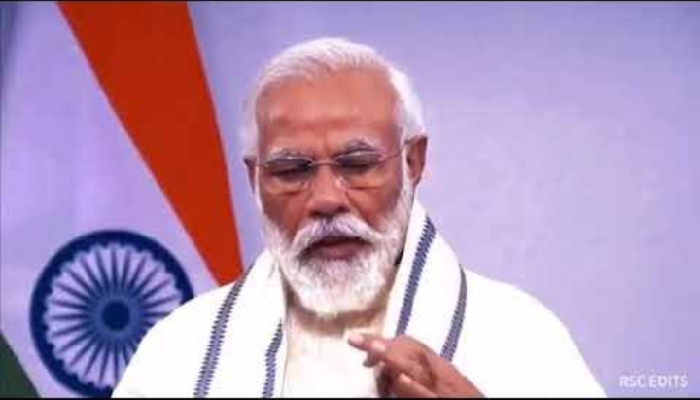New Delhi, Apr 2: Four people were killed today in Madhya Pradesh as violence broke out in several parts of the country due to anger over a Supreme Court ruling on atrocities against Dalit.
A 'Bharat Bandh' called by several organisations today, and supported by some political parties, saw security forces clashing with protesters with reports of vandalism, stone-pelting and firing by police in not just Madhya Pradesh but also in the states of Rajasthan, Punjab, Haryana, Uttarakhand, Jharkhand, Bihar, Odisha and Uttar Pradesh.
Even as protests began to spiral out of control in some states, the BJP-led Centre filed a review petition in the Supreme Court against its order last month, which barred automatic arrests on complaints filed under the SC/ST (Prevention of Atrocities) Act.
However, the Chief Justice of India declined to hear the urgent plea on the ruling. In its petition, the Centre sought the restoration of the earlier status by which any offence under the SC/ST Act was made a cognizable non-bailable offence.
The Centre, Dalit activists as well as several opposition parties - including the Congress and the RJD - came out against the SC's ruling, which they said dilutes the SC/ST Act and might lead to an increase in violence against Dalits.
Amid all this, Congress president Rahul Gandhi and the BJP criticised each other over today over how their respective governments treat the issue of the welfare of the Dalits.
"We have filed a review petition in the Supreme Court. I appeal to all political parties and groups to maintain peace and not incite violence," said Union home minister Rajnath Singh, even as Union law minister Ravi Shankar Prasad said, "humbly that we don't agree with the SC's reasoning behind the order."
In clashes in Madhya Pradesh's Morena, four persons were killed as protesters blocked a railway crossing and set fire to some public property. Some nine people injured in Gwalior of whom two were in critical condition. Elsewhere in the state, protesters threw stones in Bhind, and tangled with law enforcement in Sagar. In three of those four places the local administrations imposed a curfew and/or Section 144, which prohibits an assembly or more than four people. In Gwalior, Internet service was blocked until 6:00 am tomorrow.
In Uttarakhand's Dehradun, shops were forcibly shut by protesters. In Rajasthan's Jaipur shops were vandalised by unknown perpetrators, and protesters blocked railway tracks and stopped trains; in Barmar, cars and other vehicles and some public property was damaged. A ban was imposed on Internet services, bulk SMSes and MMSes in Barmer until 8 pm tomorrow. Internet services were also ordered banned in Alwar from 2.30 pm onward today.
In the NCR region, protesters squatted on tracks in several places outside Delhi, stopping trains, including the Dehradun Express and the Ranchi Rajdhani, to enforce an all India shutdown. Services were disrupted by a mob at the Ghaziabad railyard. Many trains, including the Saptakranti Express, Utkal Express, the Bhubaneswar and Ranchi Rajdhanis and the Kanpur Shatabdi were stopped ahead of Ghaziabad in Meerut and Modinagar, officials said. A mob of about 2,000 people stopped trains at the Hapur station as well, disrupting the movement of many goods trains, they added.
In Punjab, protests were witnessed in Ambala, and in Haryana in Rohtak; protests also rocked the states' common capital Chandigarh. The CBSE postponed the class 12 and the class 10 examinations scheduled to be held today in Punjab at the request of the state government in view of the 'Bharat Bandh'. The state government decided to keep all schools shut for the day, the CBSE said.
In Patna, MLAs from opposition parties, as well as some from the ruling side, demanded a resolution be passed by the House urging the Centre to take adequate measures to undo the recent Supreme Court order on arrests under the SC/ST Act. Protesters stormed the Patna Junction where they forced closure of the ticket booking counters and squatted on railway tracks disrupting movement of a number of trains.
Normal life was partially affected in several parts of Odisha as well after activists of 'Adivasi Dalit Sena' staged a rail roko at Khetrajpur station in Sambalpur which caused delay in the running of some trains, officials said. In the state capital of Bhubaneswar, activists of different Dalit organisations put up road blockade near Vani Vihar, Jayadev Vihar and Acharya Vihar areas
In Meerut in Uttar Pradesh, protesters were beaten by police personnel. And in Jharkhand's Ranchi, a clash between police and protesters led to several people being injured.
Earlier today, Congress president Rahul Gandhi and the BJP's Ravi Shankar Prasad slugged it out on the issue of the welfare of Dalits.
Rahul said that the "oppression of Dalits is in the RSS's and BJP's DNA".
"Keeping Dalits at the lowest rung of Indian society is in the DNA of the RSS/BJP. Whoever dares challenge this position is suppressed with violence," tweeted Rahul, even as a 'Bharat Bandh' is under way in the country to protest a ruling by the Supreme Court, which some say dilutes a law to protect Dalits.
The BJP's Prasad then hit back, accusing the Congress of "playing politics with BR Ambedkar", a Dalit icon and the father of the Indian Constitution.
"The Modi government and the BJP want to make one thing clear, that Dalit and Adivasi welfare is what we want, but some people are playing politics with Ambedkar," said the BJP's Prasad, targeting the Congress for staking claim to the Dalit icon's memory.
"I want to ask the Congress - which is making all this noise - one question. 'When did Ambedkar get the Bharat Ratna?' I'll tell you when he did. He got it during VP Singh's time when BJP supported that government. Ambedkar died in 1956 and Congress was ruling for decades after that (with no Bharat Ratna for Ambedkar) and the Congress asks us questions?" said Prasad.






Comments
Add new comment